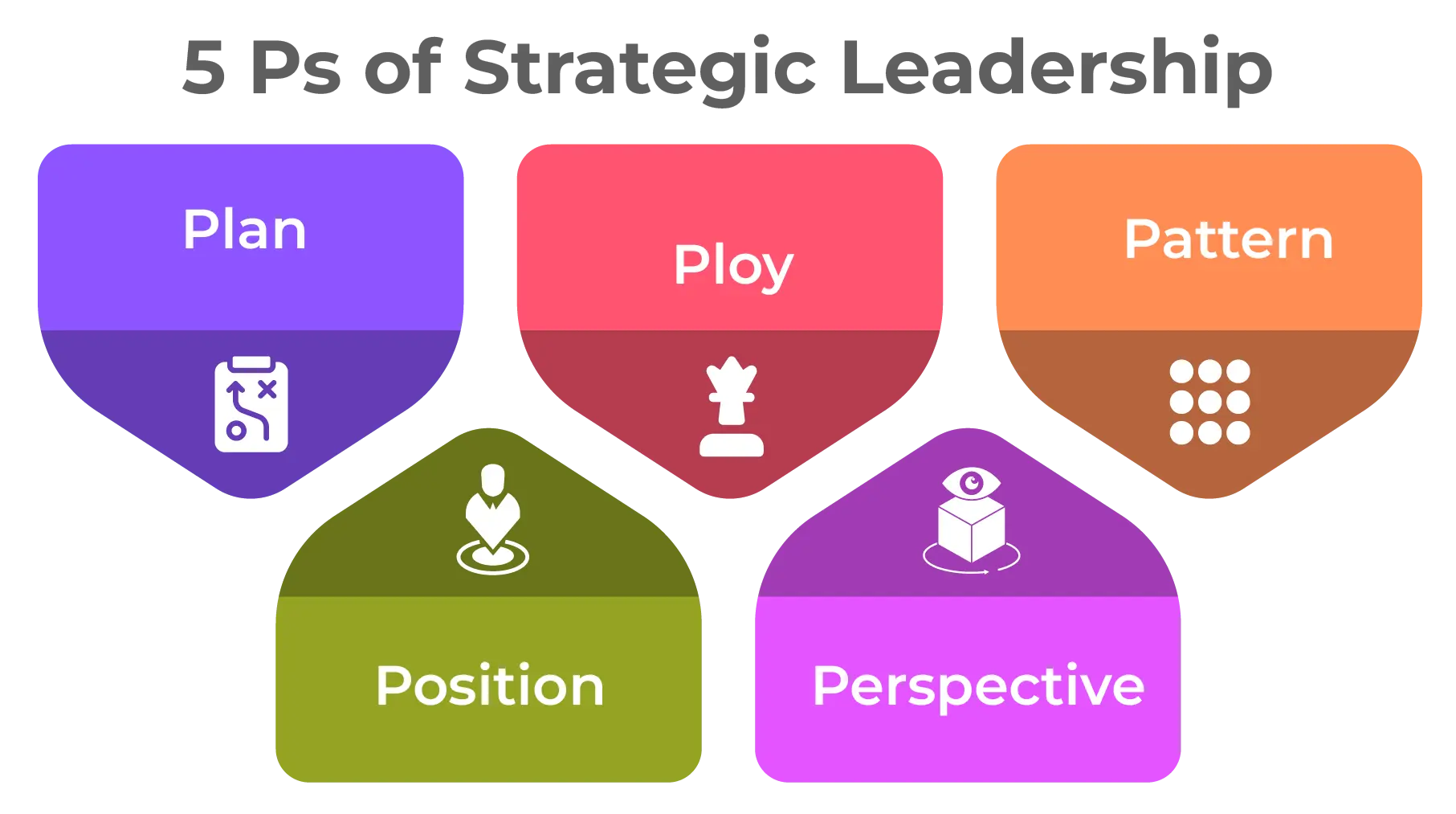By now, you would be weary of labelling all the various leadership styles prevalent in organizations. However, strategic leadership is different since it is a combination of multiple styles of leadership that help achieve goals and ensure long-term success for businesses.
Hence, let us take a deep dive into understanding what is strategic leadership with this blog.
What is Strategic Leadership?
Strategic Leadership is a form of leadership that helps guide an organization towards long-term success by developing a vision and strategizing innovative ways to achieve its goals. It involves making strategic decisions, adapting to ever-changing business environments, solving problems creatively, staying innovative, and more, to ensure the long-term success of a company.
Strategic leadership enables a company to achieve its business targets while ensuring the financial stability of the company. Hence, companies should have strategic leaders who can figure out the best methods to stay competitive in the market. Through long-term planning and anticipating future challenges, strategic leaders can safely guide an organization through any business conditions, emerging successful even in negative business conditions.
Examples of Strategic Leadership
There are various examples of strategic leadership based on how they approach their challenges to ensure the long-term success of an organization. These types utilize different kinds of methods to overcome the daily challenges and ensure that the organizational goals are met.
The four common types of strategic leadership styles are:
1. Directive Leadership
Directive leadership ‘directs’ everyone to undertake specific tasks to ensure that organizational success is assured. They set clear guidelines for the employees to follow, letting them know the expectations of their organization from them. To fulfil these objectives, they ensure that the staff follows the pre-defined path towards long-term success.
2. Visionary Leadership
Visionary leaders take a different approach towards fulfilling their organizational obligations. Instead of defining the exact path, they set clear expectations and inspire their staff members to develop the path for achieving organizational success. Hence, they set ambitious objectives and motivate their staff to achieve them.
3. Adaptive Leadership
Adaptive leaders are experts in adapting to changing business environments. Instead of following a specific path, they encourage their staff to remain flexible and develop new strategies whenever required. By remaining agile and innovative, the adaptive leadership style ensures organizational success despite the ever-changing business conditions.
4. Participative Leadership
Participative leaders ensure that their team actively participates in defining the path towards organizational success. They collaborate with their team members and take everyone’s perspective into account to ensure that everyone’s opinion is heard while defining the path towards long-term success. They also benefit from the different viewpoints of their team members, resulting in assured success.
What are the skills required for Strategic Leadership?
Since strategic leadership is critical to ensure the long-term success of any organization, strategic leaders should possess specific skills that contribute towards the development of effective tactics. These skills ensure that the plans developed by these leaders remain future-proof despite difficult market conditions and ever-changing business trends, resulting in assured success.
The essential skills required for being an effective strategic leader are:
➔ Active Listening
Active listening is essential to ensure smooth collaboration and communication with team members. It allows them to analyze the inputs shared by their team members. Additionally, they are required to communicate the vision and the organizational goals with their team, which requires them to listen actively. It helps them cultivate a culture of transparent communication and collaboration.
➔ Collaborative Mindset
Similarly, having a collaborative mindset is also essential for any strategic leader. It enables your team members to trust you as a leader since you take valuable input while making any major decisions. With a collaborative mindset, you can ensure that your employees support your goals and ensure their accomplishment.
➔ Communication Skills
Additionally, communication skills are also critical for being a successful strategic leader. With the right communication skills, you will be able to convince your supervisors about the reliability of your strategies, while also being able to convince your team about its success. It also helps develop transparency within the team, which is essential for the smooth functioning of the team.
➔ Visionary Perspective
A strategic leader should also possess a visionary perspective to be able to view the bigger picture and make strategic choices that will lead the organization towards long-term success. By being able to understand where their organization stands and make the right decisions to take it to new heights, strategic leaders prove decisive in ensuring the success of the business.
➔ Analytical Thinking
Analytical individuals can break down complex challenges into simplified problems, making it easier to develop solutions to resolve them. They can also gather insights from organizational data, helping them make data-backed decisions easily. Hence, analytical thinking is essential for being a good strategic leader for any organization.
➔ Dedication
A strategic leader should also be dedicated towards their organization since their strategies define the future of their company. Additionally, dedicated leaders also rub off their enthusiasm for their organizational success on their employees, resulting in increased productivity and engagement. Hence, being dedicated enables the strategic leader to empower their staff to work hard towards the common goal.
➔ Diplomacy
When people work in teams, there are bound to be differences among team members. In this scenario, the strategic leader should act with diplomacy and make the right decision without hurting either party. By balancing honesty with tact, you can ensure collaboration between your team members as well as with other teams. Hence, strategic leaders must possess diplomacy.
➔ Emotional Intelligence
Since the strategic leader is dealing with people, they should also possess high emotional intelligence. They should have self-awareness and empathy to understand their team members’ mentality and hence, build strong relationships with them. It helps them encourage collaboration and create a supportive environment.
➔ Innovative Nature
Additionally, having an innovative and creative streak is also a required skill for any successful strategic leader, as most of the challenges they face require unique solutions. While thinking outside the box is critical for strategic leadership, having creativity improves their strategies multiple times. They can also encourage their staff to remain creative and collaborate for excellent problem-solving for sustained success.
➔ Integrity
All the skills that we discussed until now will be futile if the strategic leader that you have chosen does not possess integrity. A manager or supervisor with integrity also encourages the employees to remain honest about their dealings with their organization. It leads to increased collaboration, improved transparency, and enhanced productivity.
➔ Adaptability
Additionally, a strategic leader should also remain adaptable, so that they can change their strategies whenever the circumstances demand it. Strategic leaders remain flexible and agile to ensure the adjustment of strategies according to changing market conditions. It enables them to stay competitive, which helps in assuring long-term success.
What are the 5 Ps of Strategic Leadership?
Mintzberg’s 5Ps of Strategy was proposed by Henry Mintzberg, a well-known academic on business management, who has written several books on business strategy.
Mintzberg’s 5Ps of Strategy are:

1. Plan
The 1st P is for ‘Plan’, which includes the creation of a robust course of action for achieving organizational objectives. Planning involves various aspects, such as goal orientation, resource allocation, decision framework development, change management, risk mitigation, contingency planning, etc.
2. Ploy
The 2nd P stands for ‘Ploy’ which is a tactic used to outsmart the competition. Using a ‘ploy’, companies can gain a major tactical advantage. Hence, various kinds of ploys are used in strategic management, like competitor disruption, psychological manoeuvring, deception, diversion, etc.
3. Pattern
The next P refers to Patterns, which are consistent actions over time, that lead to profits. Hence, a pattern becomes a strategy to enable organizations to repeat their success over time. Hence, patterns involve various aspects such as consistency, learning, adaptation, etc.
4. Position
Position refers to how an organization places itself in the market. It undermines how a company’s clients and customers perceive the brand to be different from the competition. Hence, it involves various factors such as market positioning, differentiation, value proposition, etc.
5. Perspective
Perspective is how a company conducts its daily business. It consists of various factors that make a company unique, such as organizational culture, worldview, management mindset, corporate identity, etc.
What is the role of Leadership in Strategic Management?
Leaders provide their teams with a strategy and help them achieve their objectives using these strategies. They are the ones who should inspire their employees to work harder and ensure the success of their organization. They should provide their team members with the right tools and empower them to work efficiently.
Hence, the role of leaders in strategic management can be branched into:
➔ Vision and Direction
Leaders are responsible for developing a clear and inspiring vision for their organization’s future. They are also required to guide their staff in the right direction to ensure the fulfilment of this vision.
➔ Strategy Formulation
Leaders should also guide the development of strategies by evaluating internal and external factors in an organization. They should differentiate between opportunities and threats, and make strategic choices for organization success.
➔ Resource Allocation
Leaders should also ensure that the available resources are effectively allocated to support the implementation of the chosen strategies. Having the right tools and resources results in enhanced performance management, helping the staff undertake their duties well, leading to long-term success. The improved performance can be easily measured using a dedicated performance management system.
➔ Employee Motivation
They are also required to motivate their employees to embrace new strategies and navigate changes. It helps in the creation of a culture of innovation and continuous improvement within the organization.
Read More:
➔ Goal Alignment
Effectively communicating the organization’s vision and strategy to all stakeholders also comes under the responsibilities of a leader. They are also required to ensure that their employees’ personal goals are aligned with their organizational objectives.
➔ Market Adaptability
Leaders should also adapt to changing market conditions and adjust their strategies accordingly. It helps the organization stay competitive, and remain afloat despite any market conditions.
➔ Resource Allocation
Leaders should also facilitate collaboration between different departments and external partners. It ensures that all stakeholders work together to achieve the organization’s strategic goals, which is ideal for a company’s success.
➔ Decision Making
They are also required to make critical decisions regarding resource allocation, strategic choices, and organizational priorities. Making hard decisions for the benefit of the organization and its employees is a critical skill for leaders.
Advantages of Strategic Leadership
There are multiple advantages of using strategic leadership strategies in your organization. Some of the major advantages are:
1. Long-Term Success
Strategic leadership focuses on the bigger picture and helps organizations plan for the future, leading to sustainable growth and long-term success.
2. Competitive Business
By understanding the market and competitors, strategic leaders can develop strategies that give their organization a unique edge over them.
3. Enhanced Decision-Making
Strategic leaders also make informed decisions that align with the organization’s goals and vision, leading to better business outcomes.
4. Innovative Culture
Strategic leadership also develops an environment where employees feel empowered to come up with new ideas and solutions, leading to a culture of innovation.
5. Improved Resource Allocation
Strategic leaders are adept at identifying and allocating resources efficiently. It maximizes their impact on the organization while enabling the staff members to undertake their tasks effectively.
6. Effective Planning
They also create clear plans and objectives, which ensures that all departments and employees are working towards the same goals. With effective planning, they can also ensure organizational success and employee satisfaction.
7. Risk Management
Since these leaders understand the potential risks and develop strategies to mitigate them, the organization remains safe from negative outcomes. Through effective strategic planning, companies stay on the path of progress despite setbacks.
8. Committed Employees
Strategic leaders inspire and motivate their teams, creating a sense of shared purpose and commitment to the organization’s vision. Hence, the employees remain committed towards their company, developing a sense of belonging.
9. Effective Communication
Strategic leaders communicate clearly and effectively, ensuring that all stakeholders are informed about changing strategies. Through effective and transparent communication, everyone stays updated about any changes, resulting in enhanced efficiency.
10. Increased Efficiency
Speaking of efficiency, strategic leaders also streamline processes and improve workflows, enabling companies to achieve their targets on time. With increased efficiency, businesses can also realize their vision faster than expected.
11. Team Unity
Strategic leadership also helps develop a sense of unity and teamwork, reducing conflict in the workplace. It promotes collaboration between departments, enabling efficient work, and leading to better products and services.
12. Enhanced Adaptability
Strategic leaders are also adept at adapting to changing circumstances and managing change effectively. It helps the organization continue its path towards progress despite negative market conditions.
Also Read:
Disadvantages of Strategic Leadership
As with other aspects of employee management system, strategic leadership is beneficial in most cases. However, it can also be a disadvantage in some scenarios.
Here are the major disadvantages of strategic leadership:
➔ Resistance to Change
Strategic leadership mostly involves major organizational changes, which can be met with resistance from employees resulting in reduced engagement from the staff members.
➔ Overlooking Short-Term Goals
Similarly, focusing on long-term strategic goals may lead to neglecting immediate short-term objectives and tasks. It results in reduced productivity as employees lose sight of the bigger picture.
➔ Complex Decision-Making
Strategic decisions require careful analysis, collaboration, and consideration of multiple factors, making the process complex and time-consuming. Hence, it should be performed by experts with industry knowledge as any errors could disrupt the flow of business.
➔ Disruptive Ambiguity
Similarly, frequent changes in vision and direction can create confusion and disrupt established processes. It can confuse the employees, potentially harming their morale and belief in the organization.
➔ Higher Cost of Failure
If any strategic plan fails, it can lead to significant financial losses for the company. These losses can manifest themselves in layoffs, or the cancellation of projects, making it a risky endeavour.
Conclusion
Strategic leadership is critical for helping any business reach its peak performance and efficiency, ushering it towards the path of sustained success. Hence, companies should have strategic leaders who can make the hard decisions, while ensuring employee satisfaction. It enables the organization to stay competitive in the market, ensuring long-term success.









